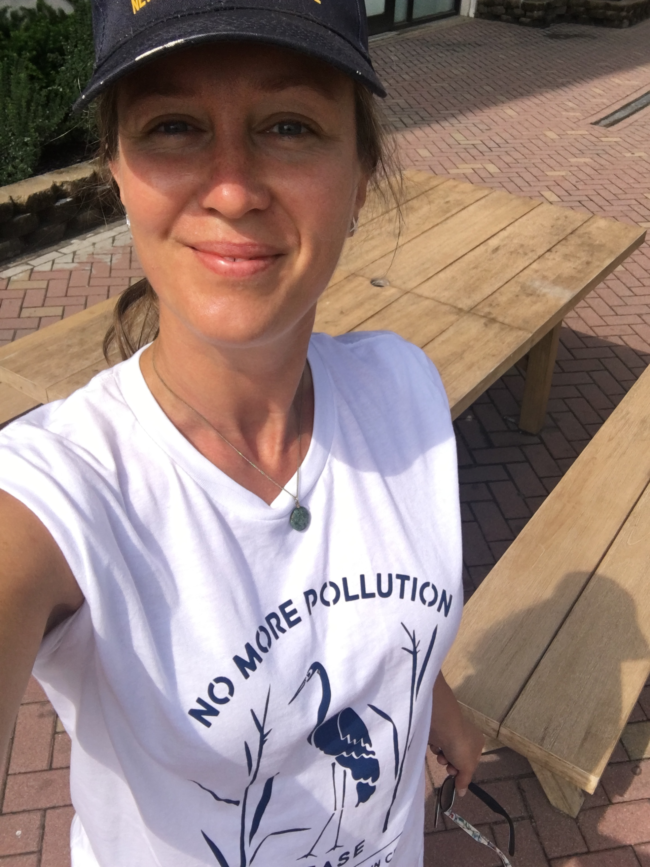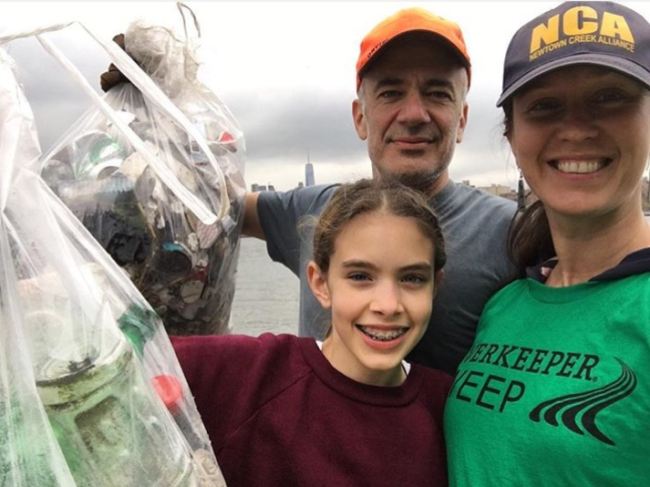Why I Sweep: Reclaiming our waterfronts

View more images on our Flickr site
 Years ago — but not quite a decade — I remember writing an email to an anonymous email account at Riverkeeper asking how I could be involved in the advocacy work around the Hudson even though I lived in North Brooklyn and my borough didn’t actually touch the river. I knew the surrounding waterbodies I was close to; the East River and the Newtown Creek, connected the larger Harbor in one vast interconnected estuary system, I wanted to be a part of the New York City community that was actively striving towards protections for healthy waters, functioning ecosystems, and importantly, waterfront access. I knew that here in New York City we are fortunate to live on a beautiful and unique collection of islands but that the relationships between the people living here and the natural systems surrounding them appeared weak. I can’t tell you how often, surprisingly, I’ve come across someone that didn’t realize they lived on an island, or who had never been to a waterfront. It still astounds me when someone realizes for the first time the geography of the City – Brooklyn and Queens are actually part of Long Island, and Manhattan and Staten Island are completely isolated from the mainland.
Years ago — but not quite a decade — I remember writing an email to an anonymous email account at Riverkeeper asking how I could be involved in the advocacy work around the Hudson even though I lived in North Brooklyn and my borough didn’t actually touch the river. I knew the surrounding waterbodies I was close to; the East River and the Newtown Creek, connected the larger Harbor in one vast interconnected estuary system, I wanted to be a part of the New York City community that was actively striving towards protections for healthy waters, functioning ecosystems, and importantly, waterfront access. I knew that here in New York City we are fortunate to live on a beautiful and unique collection of islands but that the relationships between the people living here and the natural systems surrounding them appeared weak. I can’t tell you how often, surprisingly, I’ve come across someone that didn’t realize they lived on an island, or who had never been to a waterfront. It still astounds me when someone realizes for the first time the geography of the City – Brooklyn and Queens are actually part of Long Island, and Manhattan and Staten Island are completely isolated from the mainland.
In early 2012, a group of individuals from Brooklyn, under the leadership of a wonderful Riverkeeper organizer, Dana Gulley, formed the Brooklyn Riverkeeper Action Group (we called it BRAG). We organized screenings of the movie Gasland, got involved in Superfund meetings for the Gowanus Canal and the Newtown Creek, volunteered at various events water related events, and reached out to our neighbors about the issues we valued. I had volunteered the year before in Red Hook’s Valentino Park, with a group of kayakers for the very first Riverkeeper Sweep, and had a very hard time leaving when all the other volunteers were wrapping up I kept finding what seemed to be an endless amount of styrofoam pieces and plastics of all kinds stuck in the rip-rap. I definitely stayed late, finding a very specific kind of tranquility in removing as much as I could from the water’s edge. The physical act of removing humanity’s pollution, toxins – the deadly plastic lures – was cathartic and healing. I was hooked on the experience (although it wasn’t my first cleanup) and felt compelled to do the same in my own community.
The following year I made it my vocation to rally as many groups and people as I could to lead their own Sweeps or to participate in one in as many new parks and street ends as possible in Williamsburg and Greenpoint. I took it upon myself, every year after, to rally my community in a challenge to become as hooked as I was in the Sweep.
In North Brooklyn, access to the water’s edge has been all but commonplace. Access, as well as acceptable water quality, has been an environmental right denied to its residents for more than a century, due to a long history of industrial uses along the waterfront. Uses that contributed to the forces that propelled the City and the Nation to the industrial powerhouse it was known for during the 20th Century. Notorious and powerful companies like Standard Oil got their footing and catapulted to success on these shorelines at a time when regulations were nonexistent and waters were the only way to move large quantities of goods. The forces that kept the waterfronts working had begun to shift in radical ways towards the end of the last century and in the early 21st, the status quo along the water changed forever. Beginning in 2005, the Mayor at the time, began a series of rezonings on the waterfront that stretched from the Williamsburg Bridge to the Newtown Creek. The rezonings would change the face of the waterfront and the surrounding community’s relationship to the water surrounding them from then on.
The rezonings of the waterfront have been more than contentious, gentrification has run roughshod over the sleepy neighborhoods of North Brooklyn, many, many changes have taken place here as a result of the change of use on the waterfront. Nevertheless, on the East River, there are now waterfront parks where there were waste transfer stations, open space where gas fuel was once extracted from coal. More park space is in the making at places like Bushwick Inlet Park – at the intersection of Williamsburg and Greenpoint, Box Street Park – where the East River’s fast moving waters intersect with the slow tidal rise and fall of the Newtown Creek, and under the rebuilt Kosciuszko Bridge, where few locals have ever set foot beneath.
The annual Sweep has become a day of connectivity and a celebration of our collective ability to be active participants in the fate of our waterfronts, a fate building over the recent decades due in large part to the advocacy and activism of community members. Neighbors Allied for Good Growth (NAG), where I am an active member of the Board of Directors – has led a tireless fight to reclaim the waterfront on the East River that ultimately won us East River State Park, they have led cleanups in the Park in recent years. Riverkeeper had an enormous impact on Newtown Creek, calling out the lack of action on ongoing pollution and initiating a lawsuit that spurred remediation and led to an environmental benefits settlement that the neighborhoods in Greenpoint have been utilizing to heal itself after a century of contamination.
The Sweep is one of the first steps in a whole new phase of advocacy in our long battle to claim our forgotten waterfronts. We, as a community, can now get close enough to the water’s edge to begin to care for its neglected shorelines. We no longer turn our backs to the factories that for years spoiled the waters and poisoned the life that once proliferate there. On the East River we are now turning towards our waters for refuge, recreation, education, for inspiration, and for tranquility. Newly formed groups like the Friends of Bushwick Inlet Park on the East River have used the Sweep, four years in a row, to bring volunteers out for plantings, and community building – staking a claim on the future park and its restoration as a beautiful and accessible shoreline.
On the Creek, with the Newtown Creek Alliance (NCA), where I have had the pleasure of working this past year, we are also turning a new page in partnership, forging productive relationships with industry and together, we are learning to work for the benefit of both. The Sweep has functioned as a powerful catalyst for the activation of long neglected street ends. Street ends that are the only access points to the waterway. A cleanup in 2017 saw an enormous dumpsters worth of trash removed by a dozen or so volunteers that enabled a season of plantings, path building and attention that combined truly transformed the space. It now functions more like a pocket park for weekday workers and weekend birdwatchers watchers, rather than the dumping site than it had been for the last 70+ years.
This year I will be back at the end of Meeker Ave with the NCA team of volunteers, in the “pocket park” nicknamed Penny Bridge, after the old Penny Bridge whose foundations we are restoring as a natural and recreational area. I no longer need to rally groups or individuals the way I used to throughout North Brooklyn – my neighbors sign up to be Sweep leaders without my prompting, they have friendly competitions to see who can bring more people out to the waterfront that first Saturday in May. The Sweep has become the annual action and celebration that connects us all, statewide through our waters, that I hoped it would be.
